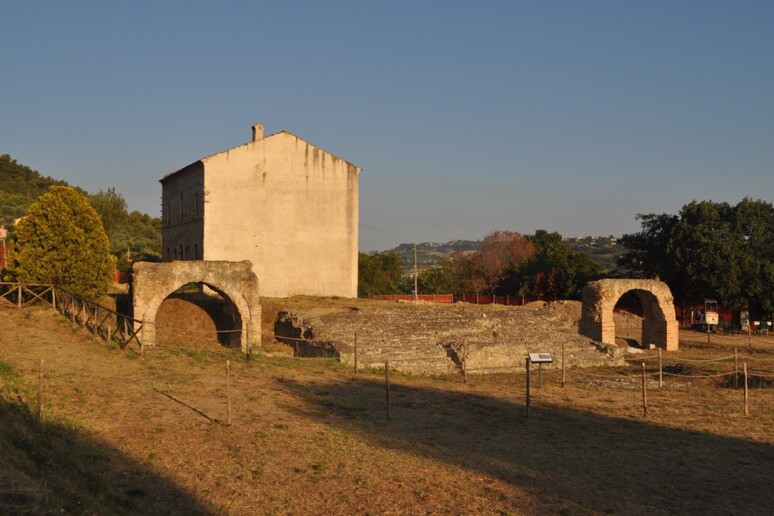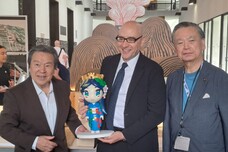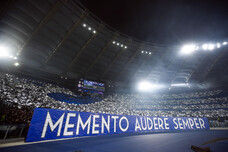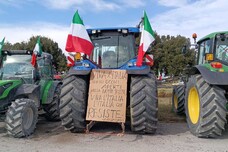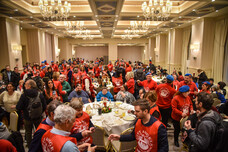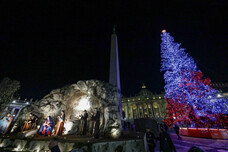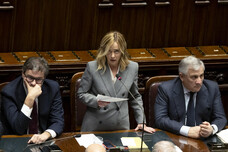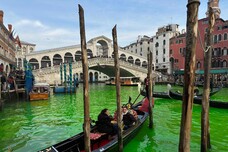(by Silvia Lambertucci) Walls with large square spaces, where the yellow of the base contrasted with the intense red and black of the central band, the colours interspersed with delicate decorations of flowers and candelabra, niches for statues and even perhaps the very high ceiling illuminated by a deep blue like an August sky.
Built at the dawn of the first century AD when Augustus reigned
over Rome, the great Roman temple of Cupra near Ascoli Piceno
was in the first phase of its life filled with colours and
images in the third Pompeian style, with the same hues and the
same decoration that at the time were shown off to their best
effect in the richest homes of Rome and Pompeii.
This is the discovery, unexpected and extraordinary, as Naples
University archaeologist Marco Giglio tells ANSA in an
exclusive, that has come from the Marche archaeological site,
where a mission by the Università Orientale, in collaboration
with the superintendency and the town council of Cupra
Marittima, which runs the Archaeological Park, has undertaken a
new campaign of excavation.
"The temples with the inside of the cell decorated with
paintings are extremely rare," Giglio points out.
"Up till today we had only known one in the III style, that of
the Bona Dea (Good Goddess) at Ostia, where, however, the
decorative style seemed much simpler, as well as the
cryptoporticus of the shrine of Urbis Salvia (at modern
Urbisaglia, near Macerata)".
The scientific director of the digs, Fabrizio Pesando of the
Orientale in Naples, goes on to explain, alongside Giglio, that
in this corner of Marche, not far from the sea and a short way
from where the Etruscans in the VI century BC successfully ran a
shrine dedicated to commerce, the Romans had settled around 100
BC, with a 'municipium' that was then promoted to the rank of
colony.
Inhabited by families of the armies of Mark Antony and Octavian
and their descendants, Cupra, which had taken its name from the
divinity of that temple (the historian Strabo says Cupra was
another name for Hera), was a flourishing little town in those
decades, with a forum and the large shrine of which today there
sadly remains very little, but which the excavations carried out
by the Neapolitan mission in the last few weeks have enabled us
to reconstruct to a certain degree. Or at least in its shape and
in the two phases of its life, underscore Giglio and Pesando.
Because more or less 100 years after its foundation, around the
first quarter of the II century AD, the temple showed grave
static problems which made it indispensable to carry out a
radical restoration, what the Romans called, in fact, an "a
fundamentis" project.
This was a "major undertaking, and a costly one", the
archaeologists explain, carried out with the same advanced
techniques that had been employed in Pompeii after the
earthquake of 62 AD, the one which preceded Vesuvius's fury by a
few years.
It is for this reason that it is hypothesized that it may have
been Hadrian himself who financed those works, Hadrian who had
been born in Spain, granted, but who descended from a family
from Atri, also in the Piceno area, and who in 127 AD made a
tour of those parts, stopping at Cupra also.
It was on that occasion, the archaeologists today say, that the
temple lost its magnificent original colours. This was because,
having to reinforce the walls that contained the shrine's cell,
the wall coverings were chiselled off too and then in all
probability covered in marble, as the fashion of the empire now
imposed.
The marvelous sky blue, just like the yellows, greens, and reds
which had illuminated that sacred space, ended up in a thousand
pieces on the floor, which the Roman builders, who were used to
recycling everything, went on to use as the base for the new
floor.
The restored temple became a Corinthian hexastyle, with the six
columns of the front that towered nine metres tall, decorated
with rich capitals. But was also embellished with a series of
semi-columns in brickwork, which were placed onto the side
walls, and dazzling lion-headed dripstones, which have also been
brought to light by the recent digs.
It was a fresh wonder that Hadrian himself had conceived, as
appears to be confirmed by an inscription found several years
ago at nearby Grottamare.
This happened while building work was buzzing all over the city
and monumental architecture was going up, including the two
powerful brick arches which still today flank the perimeter of
the temple.
And right in front of the staircase of the shrine, which is
still preserved today, there rose up the base for a celebratory
monument, perhaps even a statue of the munificent emperor.
It is a shame that in the following centuries - when this
happened is still to be clarified - all this beauty was
dismantled, the precious marbles and imposing columns were
reduced to lime to be re-used in other buildings, and even the
walls of the temple, at the end of the 19th century, were
knocked down to build a country house whose ruined remains loom
over the ancient staircase of what was the Roman shrine.
"The park is weighing whether to restore it or to remove it,"
says Giglio.
All the new finds, meanwhile, have been taken to restoration
workshops where they will be cleaned and studied. The digs will
resume in the spring and will this time focus, Giglio says, on
both the two arches and on the back of the temple, in order to
shed light on the decorations of its second phase.
Almost two thousands years after that journey by the Emperor
Hadrian, therefore, Roman Cupra is also rediscovering, little by
little, its history and its colours.
ALL RIGHTS RESERVED © Copyright ANSA
